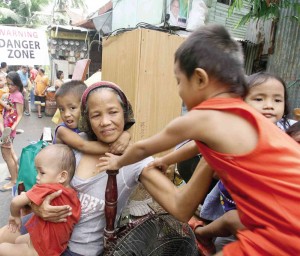
SETTLED Narcisa Arinas, 57, and her grandchildren are ready to vacate their old home by the creek in San Juan City on Monday and start a new life in Muzon, San Jose del Monte City, Bulacan. MARIANNE BERMUDEZ
Jose Llanes, 83, had lived beside the Ermitaño Creek in San Juan City nearly all his life.
But he left the place Monday to start a new life in Muzon village in San Jose del Monte City, Bulacan province.
Sadness was written across his face as workmen began to demolish his shanty on A. Luna Street.
Asked if it was because he was leaving, he said: “Yes, I’m a bit sad, of course. This is where I built my memories, where I built my family.”
Llanes loaded his belongings on truck No. 24. After the truck and an orange government van that carried his daughter Josephine and his granddaughters, among other families, left for what was to be their new home in Bulacan, the former taxi driver sat down to rest, staring at the pieces of his old house piled up on the vehicle’s bed.
They brought back memories. He said he remembered when he and his first wife lived in that house in the years after martial law.
She died at 37 of a heart disease.
“So I married again,” Llanes said, adding that his second wife, Felicidad Martinez, also lived with him in that house in San Juan.
And that was where he went home after every day’s hard work on the road.
The sight of the still waters of the creek, he said, somehow soothed him, and made him forget he was tired.
Even after he became a traffic enforcer and a barangay guard years later, he said, the same sight never failed to calm him.
“It’s like there was something in it that made me feel peace,” he said.
Even the not-so-good memories were coming back, he said.
In 2009, during Tropical Storm “Ondoy,” he and his son Jose Jr., like other people in the flooded neighborhood, climbed to the roof of their house to wait for the rescue team to take them to higher ground.
“The water almost reached the roof. It was scary,” he said.
Llanes also described how his second wife died right at the front steps of their house in 2010 as she was washing herself.
She was 85 years old.
“I remember telling her to use a stool, but she didn’t listen,” he said.
Suddenly, he said, he heard a “boom,” and he saw his second wife lying on the floor.
He felt for heartbeat, he said.
“We rushed her to the hospital anyway. But she was dead,” he said, adding his second wife had a history of hypertension.
And then Llanes smiled and said it was no use dwelling in the past.
“I will always remember those things anyway,” he said.
Better life
What was important now was that he and his family had been given the chance to build a better life.
He said that although he was sad, he and his family were thankful the government was giving them a chance to have their own home away from danger.
“Why should I be sad, I guess. It’s a new house, a new everything for us,” he said.
Everyone on the creek followed the Llaneses to Bulacan. Even the barangay captain.
Barangay Salapan Chairman Patrocinio “Boy” de la Cruz admitted that the three-story house beside Ermitaño Creek where he had lived for more than
30 years would be torn down also within the week.
The structure stands along the 3-meter easement of the waterway, an area considered a danger zone by local authorities.
A poster that read “Warning: Danger Zone” was hung right in front of the structure as a reminder to bystanders that the area should not be frequented, especially during the heavy rains.
“Of course, my family will follow and voluntarily relocate so we can set an example [to my constituents],” De la Cruz, who was helping tend to the first batch of informal-settler families to be relocated to the resettlement site in Muzon.
First batch
Ronaldo A. Lumbao, head of the city’s Urban Poor Affairs Office, said that of the 211 families that were included in a census conducted in the barangay, the 87 who complied with all the requirements—birth certificate, police clearance, pictures, among others—were the first to be relocated to the housing project.
Later in the day, however, one family opted to return to the province and proceeded with the process needed for a house in the relocation site, he said.
According to Lumbao, De la Cruz’s family was not included in the first batch because they had not submitted the birth certificate of a member.
“But it’s clear that his house is in the danger zone,” Lumbao said.
He said De la Cruz’s family and the remaining 123 others would be transferred to the resettlement area hopefully within the week.
Although his house was soon to be demolished, De la Cruz said he would have to stay behind to perform his duties as barangay chair.
He said he and his wife, Emma, would stay at his cousin’s house (which is out of the danger zone) in the same barangay.
He said they would just visit their children, who would leave for Muzon.
No more worries
Emma said leaving the house was the best option for their children. Now at least she would not worry about them every time it rained.
She was afraid of a repeat of their harrowing experience during Ondoy.
All three floors of their house were inundated, forcing them to flee to the roof.
While theirs was a “voluntary relocation,” De la Cruz’s daughter Emmilyn Caranza admitted that she felt a tinge of sadness every time she thought she was leaving the house where she grew up.
She said she would be leaving behind “many memories.”
“But [relocating] is what we need to do,” she said.